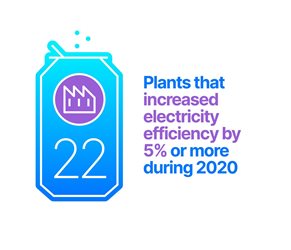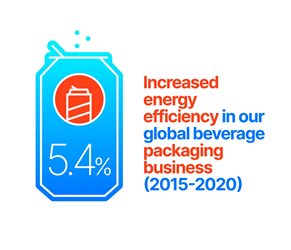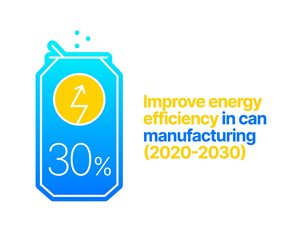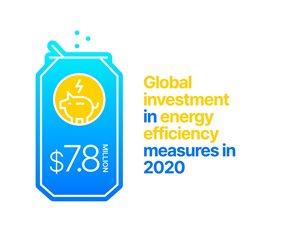

Approved Science-Based Target
In April 2020, Ball committed to an ambitious science-based target that is consistent with the level of decarbonization required to limit global warming to 1.5 degrees Celsius compared to pre-industrial temperatures.
By 2030, we will reduce our absolute carbon emissions from our own operations by 55% and within our value chain by 16% against a 2017 baseline.
Ball has reported Scope 1 and 2 greenhouse gas (GHG) emissions since 2002:
- Scope 1 emissions are direct GHG emissions from sources owned or controlled by Ball, and primarily include emissions from fossil fuels, such as natural gas and diesel, burned on site.
- Scope 2 emissions are indirect GHG emissions from the generation of electricity, heating, cooling and steam generated off site and purchased by Ball.
In 2020 Ball Corporation emitted 1.11 million metric tons of GHG emissions (Scope 1 and 2), 15% less than in 2010. Fifty-nine percent of our GHG emissions resulted from our electricity consumption, and 35% came from stationary combustion. To reduce our GHG emissions, Ball continues to increase energy efficiency and investigates options to use more onsite renewable energy.
Since 2007, we have disclosed our GHG emissions annually through CDP (formerly the Carbon Disclosure Project). Today, we submit information to three of CDP’s programs: climate change, supply chain and water. A high level of transparency of our sustainability performance, including corporate and product carbon footprints is important to ensure our customers understand our commitments and how we contribute to their own sustainability targets.
Our management and reporting systems, including internal audits, ensure the accuracy and reliability of our environmental information. We engaged ERM Certification and Verification Services (ERM CVS) to provide limited assurance in relation to our total 2020 greenhouse gas (GHG) emissions (Scope 1, Scope 2 and Scope 3).
Critical Initiatives
Ball used 4.48 million megawatt hours of energy in 2020, 3.7% more than in the previous year due to the growth in our businesses. Our Global Beverage Packaging business accounted for 89% of the total. We increased the energy efficiency in that business (measured per unit of production) by 5.4% since 2015. By using energy more efficiently, we reduce our operating costs and our carbon footprint.

Every Ball plant commits to annual energy goals supported by detailed action plans. Real-time energy information systems provide visibility into our operations at the equipment level so we can better understand, manage, report on and benchmark the performance of energy-consuming processes. All of Ball plants have formal energy management systems at year-end 2020.
To significantly and cost effectively reduce our energy consumption, we follow a global energy strategy that addresses energy supply and demand and requires the consideration of energy efficiency when making investment decisions.
Energy Efficiency

We continue to work on further improving our energy data measurement and reporting capabilities. More and more of our plants are using comprehensive energy information systems, enabling us to better understand and manage energy consuming processes in our operations and improve total system performance. Some plants are realizing significant energy savings using smaller scope energy monitoring. We will continue installing additional energy monitoring devices in our operations in 2020 and beyond.
At the same time as we are driving to reach 100% renewable energy around the world, we are also improving energy efficiency at all of our manufacturing plants. We tailor energy use reduction strategies to each of our plants, which commit to annual energy goals supported by detailed action plans. Real-time energy information systems delivered by energy meters provide higher visibility into our operations at the equipment level so that we can better understand, manage, report on and benchmark the performance of energy-consuming processes. At year-end 2019, 54% of our plants had energy monitoring systems.
Machinery and Equipment
The majority of our energy consumption comes from air compressors and ovens in our plants. In a beverage can plant, air compressors consume between 20% and 30% of the electricity. We conduct audits of our compressed air systems and optimize performance by reducing system pressure, minimizing wasteful air use and leaks, and decreasing manufacturing equipment demand. We continued to install more efficient compressors and connected additional equipment to low-pressure systems during the reporting period. At the end of 2019, 59% of our beverage can plants operated dual-air systems that supply equipment with either high- or low-pressure air. Compared to traditional systems that rely only on high pressure, low pressure compressed air is 22% more energy efficient than high pressure air, and also results in less energy loss through artificial demand. In 2019 a global team of regional staff developed a compressed air global standard for new construction projects to ensure future energy efficiency. Below are a few examples of 2020 energy efficiency efforts:
- In 2020, air compressor replacements in our Gelsenkirchen, Germany plant and Nogara, Italy plant will save a combined 4,000 megawatthours of electricity annually.
- Our Williamsburg, U.S., plant completed an air compressor audit in 2020 which resulted in several action items whose fixes resulted in nearly 900 megawatthours of electricity savings.
Within our operations, ovens are used to evaporate water from cans after being washed and to cure external and internal coatings. Ovens account for up to 75% of a beverage can plant’s natural gas usage and up to 20% of its electricity usage. Through oven audits, low-cost optimization projects, and increased employee awareness of oven energy use and associated costs, we have realized natural gas efficiency gains in our can businesses of 4.7% between 2015 and 2020.
- A 2020 burner replacement program in our Buenos Aires, Argentina, Três Rios, Santa Cruz and Recife, Brazil can plants led to a combined annual savings of 4,730 MMBtu, equal to approximately 1,386 megawatthours.
Heating and Cooling
Heating, ventilation and air conditioning (HVAC) control during the heating season is another energy efficiency opportunity. Central control systems and higher awareness of HVAC-related energy usage and costs are driving progress. We identify optimal temperatures for different areas within a plant and educate employees on how they can achieve these temperatures with the lowest energy input. Installing heat curtains, for example, reduces heat or cooling loss.
Though Ball Aerospace only accounts for less than 2% of Ball’s energy consumption, optimizing energy usage is a high priority for this business. Cleanroom operations are a major energy usage area. In these rooms, the levels of environmental pollutants, such as dust and microbes, are reduced to enable sensitive aerospace instruments and other technologies to be manufactured and tested. We continue making improvements to reduce energy consumption in operating these cleanrooms. For example, we recently modified the HVAC automation control system for one of our large cleanrooms to reduce air flow during unoccupied hours (weekday nights and weekends). The estimated electricity reduction is about 1 million kilowatt hours per year, equivalent to more than 758 metric tons of carbon dioxide equivalent emissions.
Lighting
During the reporting period, lighting continued to be a priority for our energy engineers. While it is crucial to provide proper lighting to keep our employees safe and allow them to effectively execute their jobs, lights do not need to be continually at full power. Every Ball plant changed some lighting to LED and several underwent complete conversions. We include adaptive lighting control options to further increase efficiency by matching the light levels to occupancy and daylight availability. Compared to conventional lighting, a completely converted LED plant with both lights and respective controls saves about 75% lighting electricity, with 55% of this savings from the LED and 45% from the controls. In addition to LED lighting, we are installing skylights and additional windows in some of our facilities to better utilize daylight.
Employee Awareness and Engagement
A team effort is required to achieve our plant energy reduction goals. That is why several facilities established formal voluntary energy conservation or broader sustainability teams. Ball's metal beverage packaging plant in Fort Atkinson, Wisconsin, has a multi-year track record of engaging its employees in energy conservation efforts and improving energy efficiency. Between 2010 and 2020, the plant improved its electricity efficiency by 18.6%. And the team in Fort Atkinson continues to develop and test new ideas to further maximize the value of our existing businesses.
Renewable Energy
In 2019, we signed two landmark 15-year virtual power purchase agreements for 388 megawatts of new renewable energy in North America, generated by wind and solar power. As a result, we will be addressing 100% of our electricity load in North America with renewable energy by the end of 2021. Allowing Ball to effectively reduce our global Scope 2 GHG emissions by 50%; the equivalent of removing 180,000 passenger vehicles from the road annually.
With our science-based target goals in mind, we are also moving quickly to focus on other markets, and have increased our commitment to sourcing renewable energy in Europe. In 2020 we signed two long-term virtual power purchase agreements, one in Spain and one in Sweden, covering the electricity load of 10 beverage packaging plants.
These agreements will provide 93 megawatts of wind energy, addressing 63% of our European beverage electricity load (excluding Russia) by 2021 and enabling us to reduce Scope 2 GHG emissions in Europe by approximately 60%; equivalent to removing 47,000 passengers from the road annually.
With the electricity produced from wind projects, plus additional guarantees of origin purchased and retired in Europe, Ball sourced 44% of its global electricity demand in 20211 from renewables.
1. Ball is awaiting final data assurance of its environmental data, which will be complete in February, 2022.
A Multifaceted Approach

Opposing trends, such as increases in can sizes, shapes and labels, line or plant curtailments,_Energy-Bold.jpg and new line startups, often offset progress toward our energy efficiency goals. Our efficiency decreases as manufacturing line stoppages increase due to reduced demand or we experience a greater number of height, diameter or label changes. In particular, our beverage packaging business continues to experience a decline of standard can sizes, growth of our specialty can business and shorter production runs. To manage these challenges effectively, we invest in our businesses and expect additional energy performance gains in 2021 and beyond.
Committed at All Levels

Ball’s management team is committed to energy improvements and invested $7.8 million in energy-saving projects in 2020. These measures will generate estimated electricity savings of 34.2 million kilowatt hours and natural gas savings of approximately 23.1 million kilowatt hours per year, exceeding the annual energy consumption of over 5,000 average U.S. households.
Learning from Others
Partnerships with external energy experts provide tools, resources and technical assistance to enhance our efforts and allow us to learn from other organizations. For example, Ball joined the U.S. Department of Energy’s “Better Buildings, Better Plants” program in 2010 to learn about energy management best practices and benchmark our operations with those of other manufacturing companies.